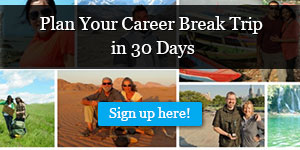Earlier in the week Amelia Tockston wrote a post about her experience with Camper Van Relocation in Australia. The following is a detailed breakdown and cost comparison for anyone interested in doing the same on their career break trip.
Details and itinerary

- I had a Britz Hi-Top, 3 person sleeper — all to myself!
- Van amenities included: stove, fridge, microwave, kettle, utensils, cups/bowls/plates, table, bed, linens/pillows/sleeping bags, sound system, sink, electrical plugs, window screens, storage bins and lights.
- I could extend my contract for $75 day (max 2 days). But in my case, I could extend for one day only, since paying customers needed the van on Dec 29 in Hobart.
- My schedule: Depart Melbourne Dec 24, arrive Hobart Dec 28.
- My US car insurance did not provide coverage for camper vans, nor did my credit card company, so I purchased insurance through the rental company:
- $12/day to reduce damage expenses to maximum $500 out-of-pocket, in the event of an accident.
- Important note: If relocation driver rolls the van, rental insurance does not apply and driver is responsible for full cost of vehicle damage. And since rolling a vehicle generally totals a car, the driver would be responsible for the cost of entire van! Horror story, a tourist from China, with no insurance of her own, rolled her luxury camper van and subsequently owed the rental company $170,000 AUD. Lesson here: DO NOT roll your camper van, take corners cautiously and slowly.
- Bond requirement: My credit card was charged $1,000 AUD. This would be refunded to my credit card upon arrival to Hobart Airport, but given two contingents:
- No damage to vehicle and I arrive ON TIME. If vehicle is returned damaged, I would forfeit up to $500 AUD. If I failed to return the van by 3 pm on December 28, I would forfeit the entire $1,000 AUD. Not a good day to be late!
- I was receiving $350 AUD towards fuel and ferry crossing. The least expensive ticket for a Melbourne to Devonport, Tasmania on Christmas Eve is $369 AUD. And this is for a recliner! Part of the pros and cons of traveling over the holidays.
My 4-day camper van itinerary

December 25 – Arrival to Devonport / Drive to Cradle Mountain National Park / Afternoon hike / Christmas dinner in camper van / Overnight at Cradle Mountain Holiday Park
December 26 – Morning hike around Dove Lake, Cradle Mountain National Park / Drive to Ross / Overnight Ross Inn Caravan Park
December 27 – Drive to Freycinet National Park / Hike to Wineglass Bay / Swim at Honeymoon Bay / Drive south to Triabuna / Overnight at Triabuna Caravan Park
December 28 – Drive Richmond / Drive to Hobart Int’l Airport, fill up petrol and clean out van / Return van to Britz office before 3 pm – don’t be late!
Additional Information
- US driver’s license and passport were sufficient for the rental (I do not have an international license).
- Relocation driver must be 21+ years of age.
- Extra Kilometer Charge: $0.55AUD
- This is the amount charged per kilometre if you exceed the kilometre allowance. This did not apply to me.
- Imoova.com charges a $25 service fee. To avoid this charge in the future, book directly through rental company, thl (www.thlonline.com).
Cost breakdown

Typical van rental expenses:
- $770 AUD – Regular daily van rental ($154 AUD/day)*
- $280 AUD – One-way fee
- $60 AUD – Van insurance through rental company
- $369.00 AUD – Ferry Crossing
- $88.27 AUD – Groceries
- $57.00 AUD – Caravan Parks
- $40.50 AUD – National Park Entrance Fees
- $102.32 AUD – Petrol
Total: $1,767.09
*Over the Christmas period, the minimum hire period is 10 days; so a normal 5-day hire is not possible unless driver is relocating the vehicle. Above $770 AUD quote is based on 5 days; a 10-day trip would be $1,540 AUD just in daily rental fees!
Relocation expenses:
- $20 AUD – Daily Rental Fee ($5/day)
- $75 AUD – Extra rental day
- $60 AUD – Van insurance through rental company
- $25 AUD – Imoova service fee
- $32.18 AUD – Ferry Crossing (difference from reimbursement from rental company)
- $88.27 AUD – Groceries
- $57.00 AUD – Caravan Parks
- $40.50 AUD – National Park Entrance Fees
- $102.32 AUD – Petrol
Total: $500.27 AUD
Total savings: $1,266.82
Amelia Tockston has maintained a longterm love affair with travel. Since beginning her career break in January 2013, she has explored New Zealand’s north and south islands, eastern Australia, Chukotka Russia, Mexico City, Singapore, Palau in the South Pacific, Indonesia, and hopes to reach Nepal and India this coming fall. Prior to taking her career break, she worked for an expedition travel company for nearly eleven years directing the Marketing department. Amelia feels the most alive and present when traveling and has an eye to appreciate the boundless wonders that Mother Nature offers. She’s also realized, particularly while on sabbatical, that the people she’s encountered and their stories are equally as inspiring as the destinations discovered.





 Jade Johnston is a Canadian expat who now lives in Australia. She writes about budget travel, destination and adventure travel, and family travel on her blog,
Jade Johnston is a Canadian expat who now lives in Australia. She writes about budget travel, destination and adventure travel, and family travel on her blog, 









